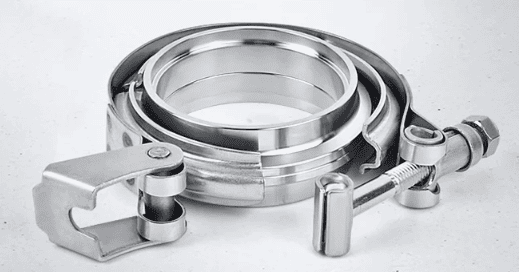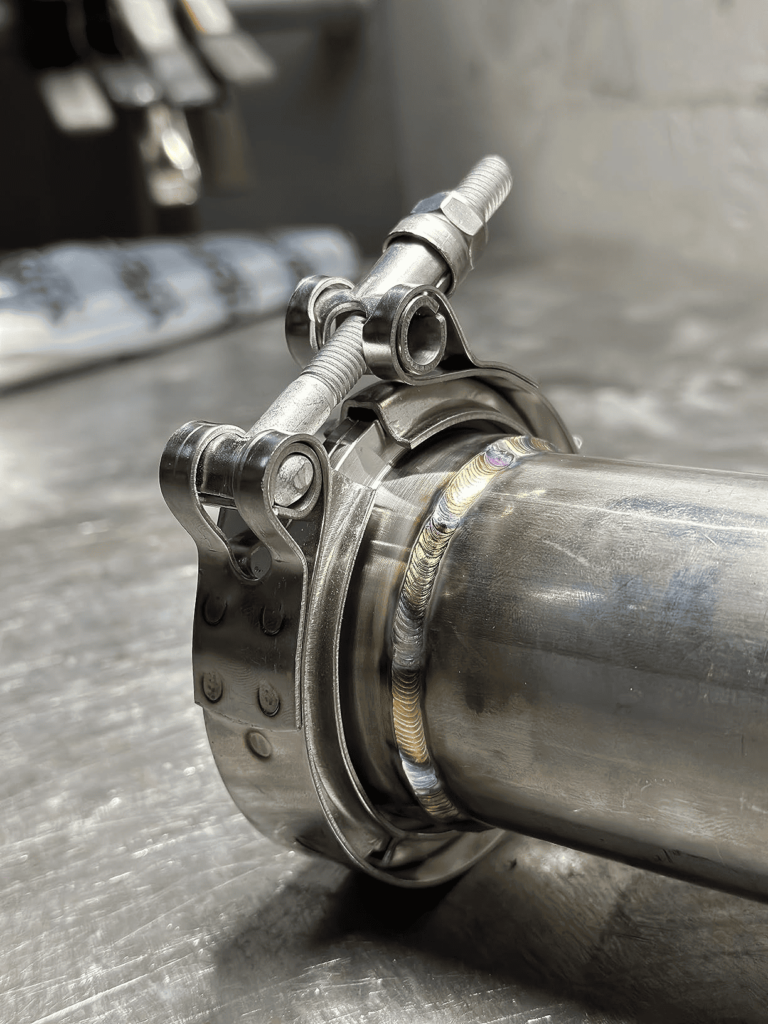Зажимы V-диапазона имеют много преимуществ, таких как более высокая установка и удаление, Нет утечки, сопротивление высокого давления, и т. д.. Это руководство проведет вас через их преимущества, сравнения, Профессиональные советы и установка подробно.
V-зажим-это тип зажима, используемого для создания прочного уплотнения между подключениями трубки. Он состоит из V-образной металлической полосы и фланцев. Когда вы затягиваете гайку зажима, он сжимает фланцы V-углу вместе, применяя даже давление в течение всего пути. Эта конструкция устраняет необходимость в болтах или прокладках, что делает его отличным для высокой вибрации, Приложения с высоким нагреванием, такие как выхлопные и турбоистры.
Давайте рассмотрим, как работают зажимы V-диапазона и как выбрать, установить, и т. д..
Как работает V-band?
Система V-диапазона состоит из трех основных частей: Два фланца (приваренные до конца труб) и зажим. Фланцы формируются как конус с V в середине. Когда вы затягиваете зажимную гайку, он собирает фланцы вместе. V-угж заставляет зажим вместе, Создание ровного давления полностью и создавать плотное уплотнение, которое не протекает.
Из -за того, как он вместе входит, он может справиться с небольшим количеством смещения и вибрации, что делает его идеальным для автомобильных приложений, где все становится горячим и стрессовым.
V-Band Clomps хороши для выхлопных газов?
Вы держите пари! V-диаграммы популярны по производительности и выхлопным системам, потому что они:
Облегчить разобрать вещи и собрать их вместе
Не требуют прокладки или герметик
Оставайтесь напряженными и на месте даже при высокой температуре и вибрации
Сделать хорошо, плотное соединение, которое выглядит чисто
Системы V-диапазона более надежны со временем, Особенно в выхлопных и турбо-установках V-диапазона, чем зажимы или фланцы полосы.
Что такое V-диапазон турбо?
В турбо-установке V-диапазона, Зажимая V-полоса используется для соединения корпуса турбины к вниз или в средней трубе. Это позволяет вам заменять турбины быстрее и устраняет такие проблемы, как утечки выхлопных газов на турбо -фланце. Особенно удобно в узких бухтах двигателей, где трудно получить гаечный ключ на болтах.
Бонус: V-диапазоны обычно позволяют вращать корпус 360 °, что облегчает затопление корпуса.
Как установить зажим V-диапазона
Сварки оба фланца к концу трубы, убедиться, что они идеально выровнены.
Положите анти-предыдущие на зажимной гайке, Так что это не желчное.
Собрать фланцы и положить зажим.
Затянуть гайку равномерно. Используйте крутящий ключ, чтобы убедиться, что он достаточно напряжен.
Проверьте на утечки с дымом или мыльной водой.
Плюсы и минусы использования зажимов V-диапазона
Плюсы
- Не протекает под высоким давлением
- Легко собрать/разобрать
- Никаких прокладок не требуется
- Может повернуться, чтобы его выстроили в очередь
Минусы
- Более дорогим, чтобы начать
- Вы должны приваривать его
- Может быть перегружен и разрушен
- Если вы не поместите это вправо, это может освободиться
Общие ошибки зажима V-диапазона и как их избежать
- Перегрузка: Снимите потоки или деформируется за зажим
- Просмотр: Вызывает утечки и ослабление вибрации
- Смещение фланцев: Предотвращает правильное герметизацию и вызывает переломы напряжения
- Нет анти-серии: Делает удаление кошмаром
Избегайте этих проблем, не торопившись и используя крутящий ключ.



